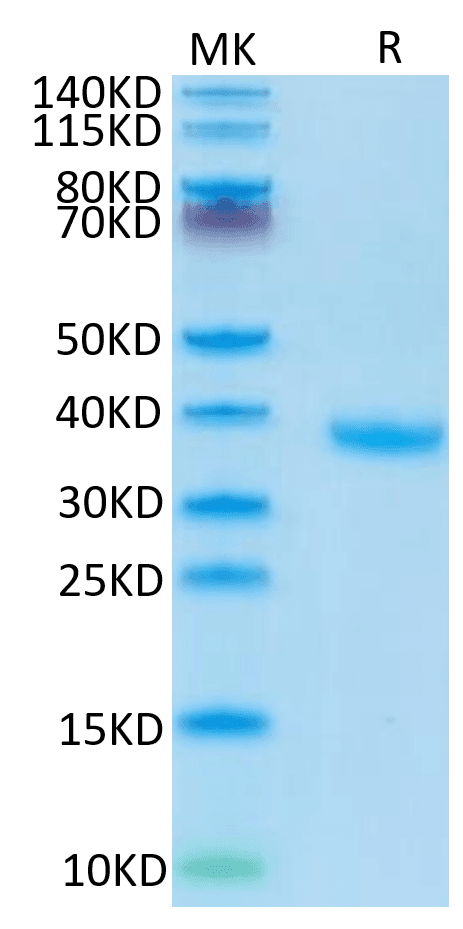| Weight | 1 lbs |
|---|---|
| Dimensions | 9 × 5 × 2 in |
| accession | O95633 |
| express system | HEK293 |
| product tag | C-His |
| purity | > 95% as determined by Tris-Bis PAGE |
| background | Follistatin-like 3 (FSTL3) is a novel cytokine that regulates insulin sensitivity and counteracts activin/myostatin signalling. In the present study, regulation of FSTL3 in renal dysfunction was investigated in both human chronic kidney disease (CKD) and acute kidney dysfunction (AKD). Furthermore, mFSTL3 expression was analysed in insulin-sensitive tissues in a mouse model of CKD. |
| molecular weight | The protein has a predicted MW of 26.1 kDa. Due to glycosylation, the protein migrates to 35-40 kDa based on Tris-Bis PAGE result. |
| available size | 100 µg, 500 µg |
| endotoxin | Less than 1EU per μg by the LAL method. |
Human FSTL3 Protein 4001
$270.00 – $900.00
Summary
- Expression: HEK293
- Active: Yes (cell based assay)
- Amino Acid Range: Met27-Val263
Human FSTL3 Protein 4001
| protein |
|---|
| Size and concentration 100, 500µg and lyophilized |
| Form Lyophilized |
| Storage Instructions Valid for 12 months from date of receipt when stored at -80°C. Recommend to aliquot the protein into smaller quantities for optimal storage. Please minimize freeze-thaw cycles. |
| Storage buffer Shipped at ambient temperature. |
| Purity > 95% as determined by Tris-Bis PAGE |
| target relevance |
|---|
| Follistatin-like 3 (FSTL3) is a novel cytokine that regulates insulin sensitivity and counteracts activin/myostatin signalling. In the present study, regulation of FSTL3 in renal dysfunction was investigated in both human chronic kidney disease (CKD) and acute kidney dysfunction (AKD). Furthermore, mFSTL3 expression was analysed in insulin-sensitive tissues in a mouse model of CKD. |
| Protein names Follistatin-related protein 3 (Follistatin-like protein 3) (Follistatin-related gene protein) |
| Gene names FSTL3,FSTL3 FLRG UNQ674/PRO1308 |
| Mass 9606Da |
| Function Isoform 1 or the secreted form is a binding and antagonizing protein for members of the TGF-beta family, such as activin, BMP2 and MSTN. Inhibits activin A-, activin B-, BMP2- and MSDT-induced cellular signaling; more effective on activin A than on activin B. Involved in bone formation; inhibits osteoclast differentiation. Involved in hematopoiesis; involved in differentiation of hemopoietic progenitor cells, increases hematopoietic cell adhesion to fibronectin and seems to contribute to the adhesion of hematopoietic precursor cells to the bone marrow stroma. Isoform 2 or the nuclear form is probably involved in transcriptional regulation via interaction with MLLT10. |
| Catalytic activity #N/A |
| Subellular location [Isoform 1]: Secreted.; [Isoform 2]: Nucleus. Note=Although alternative initiation has been demonstrated and resulted in different localization, the major source of nuclear FSTL3 appears not to depend on translation initiation at Met-27 according to. |
| Tissues Expressed in a wide range of tissues. |
| Structure Interacts with INHBA and INHBB. Interacts with FN1. Interacts with ADAM12. Isoform 2 interacts with MLLT10; the interaction enhances MLLT10 in vitro transcriptional activity and self-association. Interacts with MSTN. |
| Target Relevance information above includes information from UniProt accession: O95633 |
| The UniProt Consortium |
Data
Publications
Publications
| pmid | title | authors | citation |
|---|---|---|---|
| We haven't added any publications to our database yet. | |||
Protocols
| relevant to this product |
|---|
Documents
| # | ||
|---|---|---|
| Please enter your product and batch number here to retrieve product datasheet, SDS, and QC information. | ||


















